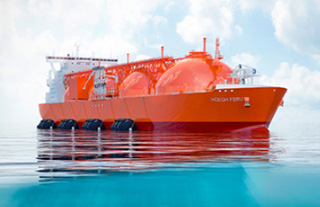A proposed offshore liquefied natural gas port near New York City would take 20 months to build, and when complete in late 2018 be capable of offloading LNG tankers, warming as much as 400 million cubic feet of fuel daily for transmission into the region’s natural gas network.
That is the plan, as outlined in a newly released final environmental impact statement on the Port Ambrose project proposed by Liberty Natural Gas LLC, Short Hills, N.J. The company is working with Höegh LNG of Norway, which designs and operates LNG carrier vessels and terminals, to get federal permits for the East Coast’s fifth LNG terminal.
 A map of the proposed project. Image via Port Ambrose.The developers’ preferred site is 16 miles south of Jones Beach, N.Y., and about 27 miles outside the entrance to lower New York Harbor, and would involve work over up to 250 acres of sea floor, according to the EIS document.
A map of the proposed project. Image via Port Ambrose.The developers’ preferred site is 16 miles south of Jones Beach, N.Y., and about 27 miles outside the entrance to lower New York Harbor, and would involve work over up to 250 acres of sea floor, according to the EIS document.
The terminal would consist of two subsea submerged turret loading buoys, of proprietary design by Advanced Production and Loading, Arendal, Norway. The buoys couple into docking bays on the bottom of LNG carrier ships that have on-board regasification for offloading the fuel.
The buoys would be connected by flexible risers to 26” diameter pipeline laterals in the sea floor, those would converge into a single 26” main line, laid 18.8 miles west to tie into the existing Transcontinental Gas Pipe Line Company (Transco) Lower New York Bay Lateral sub-seafloor pipeline that connects New York and New Jersey.
Shoreside support for construction, pipe staging and concrete weight coating could be in three locations being considered by the company, including the Port of Coeymans Marine Terminal, far up the Hudson River in New York, and the Construction & Marine Equipment Co., Inc., yard on the Arthur Kill waterway in New Jersey. The third site, even farther away, is at Point Quonset in North Kingston, R.I., a location in Narragansett Bay that is being heavily promoted by Rhode Island officials as a staging port for offshore wind energy development, too.
MARAD and Coast Guard reviewers cautioned the EIS document includes some safety considerations, “but does not function as the final safety evaluation.” A separate port operations manual must be prepared and approved by the Coast Guard for Port Ambrose, and MARAD is evaluating financial responsibilities associated with the project as part of the final licensing decision.
Liberty Natural Gas touts energy reliability and cost effects of the project for energy consumers, with the capability to bring in additional natural gas during winter peak demand and high prices. The company campaigned hard for support from New York region business and labor groups.
On the other side, opponents include regional ocean environmental groups and fishermen who oppose new industrial development offshore in the New York Bight, and foresee future use of the region’s ports to export LNG derived from Pennsylvania’s Marcellus shale gas fields. In 2011 they helped push New Jersey Gov. Chris Christie to oppose an earlier LNG port application, and are looking to derail Liberty’s bid now.
Liberty and its partners have a similar proposal for a deepwater LNG port in Morecambe Bay, off Barrow in the northwest United Kingdom, hoping to tap into the growing natural gas markets of the UK’s National Grid.
While natural gas is cleaner burning than other fossil fuels, national environmental groups have been fighting its expansion, arguing the nation could become overly reliant on it at the expense of developing solar and wind energy. The Union of Concerned Scientists took an economic tack too, arguing that New York and New Jersey are over-committing to natural gas, and could be in for future price shocks when today’s market glut is over.




